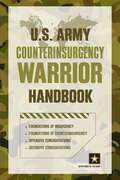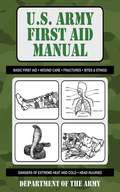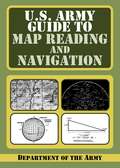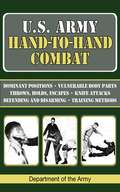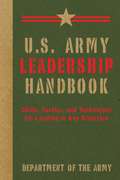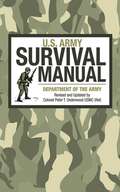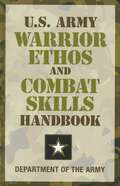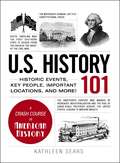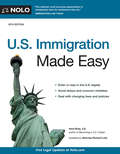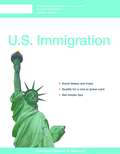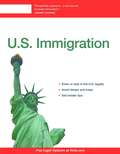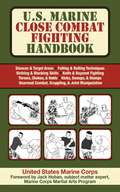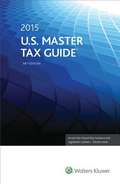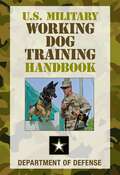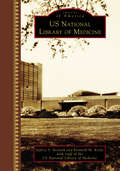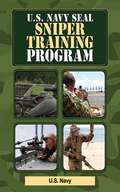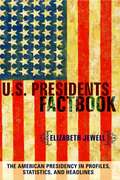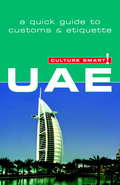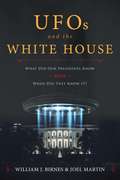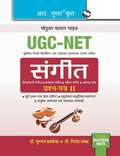- Table View
- List View
U.S. Army Counterinsurgency Warrior Handbook
by Department of the ArmyIn the global War on Terror, among the greatest threats to the United States military are insurgent uprisings. Enter the U.S. Army Counterinsurgency Warrior Handbook, the counterinsurgency playbook used by the greatest army in the world. This manual establishes fundamental principles for tactical counterinsurgency operations at the company, battalion, and brigade level. It is based on lessons learned from historic counterinsurgencies and current operations. The realities of today&’s operational environment—an environment modified by a population explosion, urbanization, globalization, technology, the spread of religious fundamentalism, resource demand, climate change and natural disasters, and proliferation of weapons of mass destruction. Both a boots-on-the-ground field guide to defeating an insurgency in a nation where the U.S. military has oversight and a high-level leadership guide for commanders organizing counterinsurgency efforts, this book—which includes battle diagrams and illustrations—is not only a must-read for military buffs, but also a valuable resource for business and gaming strategists.
U.S. Army First Aid Manual (US Army Survival)
by ArmyU.S. Army First Aid Manual offers skills and knowledge necessary for many life-threatening situations, with an emphasis on treating oneself and aiding others-of use to soldiers in the field, to outdoorsmen, or to anyone who may find themselves in a dangerous situation without a medical professional on-hand. This is the official manual for treating every type of injury and affliction in the field. Covering a broad range of topics in precise, easy-to-understand language, it emphasizes prompt and effective action in sustaining life and preventing or minimizing further suffering and damage. U.S. Army First Aid Manual is fascinating reading for anyone with an interest in military practice and an essential handbook for anyone who is regularly away from immediate medical care.
U.S. Army Guide to Map Reading and Navigation (Us Army Ser.)
by ArmyIt requires no prior knowledge of these subjects. Sections include map care, comprehension of map symbols, military symbols, grid reference systems, and interpretation of aerial photographs. After the basics are covered, the second half moves to land navigation - varying terrains, elevations, day-night variations. Map and compass work is thoroughly explained. Finally, extreme scenarios - desert, mountain, jungle, arctic, and urban terrains - are all explored.
U.S. Army Hand-to-Hand Combat: Training - Ground-fighting - Takedowns And Throws - Strikes - Handheld Weapons - Standing Defense - Group Tactics (US Army Survival)
by ArmyIn close-quarter combat, there is no second chance and no room for error. On the street, as in military combat, even the smallest mistake can make the difference between life and death. U.S. Army Hand-to-Hand Combat is the official field manual (FM 21-150) used by U.S. Army soldiers-men and women trusted, trained, and tasked to protect the United States from enemies in every kind of situation. From a rundown of training methods to essential information about throws, holds, escapes, knife attacks and more, it covers every tactic and scenario clearly and thoroughly. When weapons are unavailable or not advisable, the techniques in this manual will show every reader the skills necessary to neutralize an attacker swiftly and effectively.
U.S. Army Human Intelligence Collector Field Manual
by Department of the ArmyAmong the most crucial roles of the United States military in the global War on Terror is the collection of human intelligence from prisoners of war, unlawful combatants, and others. On the heels of controversy over some of the techniques used to extract information—such as waterboarding—the Department of the Army completely revised its interrogation guidelines. The result is this book, the United States Army&’s human intelligence collection playbook, which gives instructions on the structure, planning and management of human intelligence operations, the debriefing of soldiers, and the analysis of known relationships and map data. The largest and most newsworthy section of the book details procedures for screening and interrogation, which permits a specific number of interrogation techniques, described in Chapter 8 as &“approach techniques.&” These techniques, described in great detail, carry such names as Emotional Love,Mutt and Jeff, False Flag, and even Separation. A must-read for today&’s military buffs, U.S. Army Human Intelligence Collector Field Manual is also a valuable resource for anyone seeking strategies to employ in the gathering of information.
U.S. Army Leadership Handbook: Skills, Tactics, and Techniques for Leading in Any Situation
by Department of ArmyWhat does it take to lead an army in battle? What does it take to win? Competent leaders of character are essential for the Army to meet the challenges in the dangerous and complex security environment we face today. The U.S. Army Leadership Handbook (FM 6-22) is the Army's flagship field manual on leadership. It establishes leadership doctrine and fundamental principles for all officers, noncommissioned officers, and Army civilians across all components using the "BE-KNOW-DO" concept. It is critical that Army leaders be agile, multiskilled athletes who have strong moral character, broad knowledge, and keen intellect. Leaders-military and civilian alike-must set the example, teach, and mentor, and this manual provides the principles, concepts, and training to accomplish this important task. Filled with leadership principles crucial to the U.S. military and equally applicable to leaders in any walk of life, this up-to-date manual from the Army will teach all leaders everything they need to know.
U.S. Army Survival Manual (US Army Survival)
by Army Peter T. UnderwoodThis comprehensive new edition of U.S. Army Survival Manual, issued by the Department of the Army and thoroughly revised by Colonel Peter T. Underwood USMC (Ret), is ideal for military personnel and all outdoors enthusiasts. From the psychology of survival and basic medicine to personal camouflage and signaling techniques, this essential resource provides all the information you need to survive. Included here is a guide to identifying: Poisonous snakes and lizards Edible plants Cloud formations as foretellers of weather And more! With detailed photographs and illustrations and an extensive set of appendices, U.S. Army Survival Manual is your ultimate guide to survival in all conditions and environs.
U.S. Army Warrior Ethos and Combat Skills Handbook (U.S. Army)
by Department of the ArmyThis is the Soldier's Field Manual. It explains how to perform the combat skills needed to survive on the battlefield. All Soldiers, across all branches and components, must learn these basic skills.
U.S. Army Weapons Systems 2010-2011
by ArmyFrom the Advanced Threat Infrared Countermeasures to the XM320 grenade launcher, this comprehensive guide profiles nearly every weapon currently in use by the U.S. Army. In addition, it covers cutting-edge technology that will soon be employed by soldiers around the world. Missiles, small arms, biological detection systems, rockets, reconnaissance systems, radios, planes, bows and arrows (believe it or not)-you name it, this book has it. Also included is a thorough discussion of Future Combat Systems (FCS), the system of systems that, when fully operational, will provide the army and the joint force with an unprecedented capability to see the enemy, engage him on their terms, and defeat him on the twenty-first-century battlefield.
U.S. Constitution Book (The Everything®)
by Ellen M KozakDebates over constitutional rights impact you every day as an American citizen. But do you know what the U.S. Constitution actually says? This accessible guide contains the complete text of the Constitution, with short, descriptive margin notes throughout. Articles and amendments are then analyzed in depth to help you comprehend the basis of democracy. This valuable handbook covers:How the articles and amendments were draftedInsight into the intentions of the creators and the sources they usedControversial interpretations and Supreme Court decisionsHow the Constitution affects citizens every dayThe Declaration of Independence, the Articles of Confederation, and unratified Constitutional amendmentsThis book walks you through the history of this essential document and shows how it has guided lawmakers and judges for more than 200 years. This unbiased look at the Constitution will help you feel confident in your knowledge of this all-important document, gain a firmer understanding of how our government works, and put context around today's most pressing issues.
U.S. History 101: Historic Events, Key People, Important Locations, and More! (Adams 101 Series)
by Kathleen SearsPerfect for readers of all ages, U.S. History 101 is a fact-filled and riveting introduction to the most important political events and figures from the last 300 years of our nation&’s history.The stories of politicos and historic events are often turned into snooze-worthy lectures that even Benjamin Franklin would reject. This guide cuts out all the boring details and instead provides you with a thrilling lesson in U.S. history. From Thomas Jefferson and the Declaration of Independence to Barack H. Obama and the Great Recession, each page takes you on an unforgettable journey through the moments that completely changed this country. You'll also uncover hundreds of entertaining historical facts and stories that you won't be able to find anywhere else. So whether you're looking to unravel the mysteries of America's past or just want to learn more about our country's presidents, U.S. History 101 has all the answers--even the ones you didn't know you were looking for.
U.S. Immigration Made Easy
by Ilona BrayWant to live, work, or travel in the United States? U.S. Immigration Made Easy has helped tens of thousands of people get a visa, green card, or other immigration status. You’ll learn: whether you and your family qualify for a short-term visa, permanent U.S. residence, or protection from deportation how to obtain, fill out, and submit the necessary forms and documents insider tips on dealing with bureaucratic officials, delays, and denials strategies for overcoming low income and other immigration barriers, and how to select the right attorney. U.S. Immigration Made Easy provides detailed descriptions of application processes and helps you avoid traps that might destroy your chances. There’s also an immigration eligibility self-quiz, which helps you match your background and skills to a likely category of visa or green card. The 19th edition is completely updated to cover recent legal and fee changes including Trump administration efforts to end TPS for various countries and end DACA. NOTE: Does not cover naturalization.
U.S. Immigration Made Easy
by Ilona Bray J.D.What U.S. law says about who is eligible to immigrate, whether on a permanent or temporary basis, can be hard to interpret, and even harder to act upon. U.S. Immigration Made Easy, however, demystifies the system, discussing almost every possible way to legally enter, live in, or stay in the United States. Learn how the immigration system really works and find out whether you qualify for: a work visa a student visa asylum or refugee status a green card through family, employment, or in some other category Deferred Action for Childhood Arrivals (DACA) and more Get tips on dealing with paperwork, government officials, delays and denials. Plus, you'll get step-by-step instructions on filling out and filing forms, and learn the best way to approach the enormous U.S. government bureaucracy. Thoroughly updated and revised, this edition covers the latest changes in immigration law, including new opportunities for same-sex couples, the new "provisional waiver of unlawful presence" (offering a new path to a green card to family members of U.S. citizens, the latest average processing times, and much more. It also discusses important changes made by President Obama's Executive Order of November 20, 2014.
U.S. Immigration Made Easy
by Ilona Bray J.D. Richard LinkMany people have misconceptions about the complex tangle that is U.S. immigration law. Even a prospective immigrant with simple questions about who is eligible to come to the U.S. on a permanent or temporary basis will find the rules hard to interpret, and even harder to act upon. U.S. Immigration Made Easy demystifies the system, discussing almost every possible way to legally enter, live in, or stay in the United States. Learn how the immigration system really works and find out whether you qualify for: a work visa a student visa asylum or refugee status a green card through family, employment, or in some other category Deferred Action for Childhood Arrivals (DACA) a U visa, and more. Get tips on dealing with paperwork, government officials, delays and denials. Plus, you'll get step-by-step instructions on filling out and filing application forms, and learn the best way to approach the enormous U.S. government bureaucracy. Thoroughly updated and revised, this edition covers the latest changes in immigration law, including expansion of the new “provisional waiver of unlawful presence” to family members of lawful permanent residents living in the U.S.), the latest average processing times, and much more.
U.S. Marine Close Combat Fighting Handbook
by United States Marine Corps.There are currently more than 200,000 active-duty U.S. Marines and another 40,000 in the reserves. These Marines depend on the skills and techniques taught in this concise manual--and now you can, too! This fully illustrated guide features the LINE (linear in-fighting neural-override engagement) system, which is designed to be learned and memorized through repetition. Once the techniques are fully acquired, they should be applied instinctively. The U.S. Marine Close Combat Fighting Handbook explains the methods to quickly neutralize any attacker in close quarters and teaches you how to use any part of the human body as a weapon. It covers breaking a fall, defending against headlocks and chokes, protecting against punches and kicks, surviving encounters with armed attackers, and more.
U.S. Master Tax Guide (2015), 98th Edition
by Wolters Kluwer CCH Editorial Staff PublicationThis edition provides helpful and practical guidance on today's federal tax law and reflects all pertinent federal taxation changes that affect 2014 returns and provides fast and reliable answers to tax questions affecting individuals and business income tax.
U.S. Military Working Dog Training Handbook
by Department of DefenseLearn how to train your dog exactly as the U.S. military trains its canine soldiers. This manual is the Department of Defense’s principle source of information on care, conditioning, and training of our nation’s Military Working Dogs – such as “Cairo,” the canine who served in the raid that killed Bin Laden. From basics, such as “HEEL” and “STAY” to negotiating obstacle courses, to tracking, searching, and even attacking . . . this manual shows readers how our military trains their dogs to be the best trained canines in the world. Contents include: * Veterinary Training Priorities * Principles of Conditioning and Behavior Modification * Patrol Dog Training * Clear Signals Training Method * Deferred Final Response * Detector Dog Training Validation * The Military Working Dog (WMD Program) * Facilities and Equipment * And more…
U.S. National Library of Medicine (Images of America)
by Jeffrey S. Reznick Kenneth M. Koyle Medicine, with staff of the US National Library ofThe US National Library of Medicine, on the campus of the National Institutes of Health in Bethesda, Maryland, has been a center of information innovation since its beginnings in the early 19th century. The world’s largest medical library and a federal government agency, it maintains and makes publicly available a diverse and world-renowned collection of materials dating from the 11th to the 21st centuries, and it produces a variety of electronic resources that millions of people around the globe search billions of times each year. The library also supports and conducts research, development, and training in biomedical informatics and health information technology, and it coordinates the National Network of Libraries of Medicine that promotes and provides access to health information in communities across the United States. As the library anticipates its third century of public service, this book offers a visual history of its development from its earliest days through the late 20th century, as the institution has involved generations of visionary leaders and dedicated individuals who experienced the American Civil War, the world wars, the Cold War, and the dawn of the information age.
U.S. Navy SEAL Sniper Training Program (US Army Survival)
by U. S. Navy"From 1962 when the first SEAL teams were commissioned to present day, Navy SEALs have distinguished themselves as an individually reliable, collectively disciplined and highly skilled maritime force. Because of the dangers inherent in Naval Special Warfare, prospective SEALs go through what is considered by many military experts to be the toughest training in the world." -U.S. Navy Once used only by authorized SEALs, U.S. Navy SEALs Sniper Training Program is now available to the historian, the military enthusiast, and the curious civilian. Covering all points from position selection and range estimation to exercises and mission planning, this manual is exhaustive. It will teach you what equipment SEAL snipers need, how they camouflage themselves, and when and how they apply fire.
U.S. Presidents Factbook
by Elizabeth JewellUp-to-date through the 2004 election, the ultimate resource on the American presidency Whether students are writing an essay on American history or parents are choosing which candidate gets their vote, theU. S. Presidents Factbookis one of the best resources on presidential history. • Up-to-date with presidents from George Washington to the winner of the 2004 election. This is the only comprehensive and unbiased coverage of more than 200 years of American leadership. • Includes each president's fa...
UAE - Culture Smart!
by John WalshAs seen in Sex and the City 2!Culture Smart! provides essential information on attitudes, beliefs and behavior in different countries, ensuring that you arrive at your destination aware of basic manners, common courtesies, and sensitive issues. These concise guides tell you what to expect, how to behave, and how to establish a rapport with your hosts. This inside knowledge will enable you to steer clear of embarrassing gaffes and mistakes, feel confident in unfamiliar situations, and develop trust, friendships, and successful business relationships.Culture Smart! offers illuminating insights into the culture and society of a particular country. It will help you to turn your visit-whether on business or for pleasure-into a memorable and enriching experience. Contents include:* customs, values, and traditions* historical, religious, and political background* life at home* leisure, social, and cultural life* eating and drinking* do's, don'ts, and taboos* business practices* communication, spoken and unspoken"Culture Smart has come to the rescue of hapless travellers." Sunday Times Travel"... the perfect introduction to the weird, wonderful and downright odd quirks and customs of various countries." Global Travel"...full of fascinating-as well as common-sense-tips to help you avoid embarrassing faux pas." Observer"...as useful as they are entertaining." Easyjet Magazine"...offer glimpses into the psyche of a faraway world." New York Times
UEFA EURO 2024 Official Kids' Guide
by Kevin PettmanThis official and exclusive kids' guide to EURO 2024 contains all the essential information young football fans need in the run-up to the Championship, which kicks off on 14th June 2024. The book features an overview of the competition's history, a lowdown of the venues in 2024, punchy team profiles and a rundown of all the star players involved, including the likes of Mbappe, Jude Bellingham, Pedri, Musiala and many others.Dynamically designed and illustrated, and with more than 125 images, the book is brimmng with facts, stats, records guaranteed to make its readers experts of Europe's biggest continental soccer tournament.
UFOs and The White House: What Did Our Presidents Know and When Did They Know It?
by William J. Birnes Joel MartinThe author team that wrote the upcoming Skyhorse title Edison vs. Tesla, as well as The Haunting of the Presidents and other titles about the weird, the supernatural, and the unexplained, turn their attention to the oval office for a unique view of UFOs in America and more specifically, what America's presidents--from Washington to Obama--have witnessed and believed. <p><p> Most of us know that George Washington was heavily involved with the secret society the Freemasons. But how many of us know about George Washington's UFO sighting during the terrible winter at Valley Forge, and how the experience guided his future?Marilyn Monroe is rumored to have had UFO intel that she gained via pillow-talk from JFK. <p> Under Nixon's presidency we orbited and walked upon the surface the moon while almost at the same time the Air Force was exploiting the Air Force as scientific cover for its decision to terminate Project Blue Book. Jimmie Carter was visited by UFOs multiple times. UFOs and the White House is an oft-overlooked glimpse at history that will appeal to historians as well as advocates of the paranormal.
UGC-NET Junior Research Fellowship and Assistant Professor Eligibility Test - Sangeet Paper-2 Part-1: UGC-NET जूनियर रिसर्च फेलोशिप और सहायक प्रोफेसर पात्रता परीक्षा संगीत पेपर-२ भाग-१
by Dr Gunjan SaxenaPaper- 2 shall consist of 100 objective type compulsory questions each carrying 2 marks which will be based on the subject selected by the candidate.
UGC-NET Junior Research Fellowship and Assistant Professor Eligibility Test - Sangeet Paper-2 Part-2: UGC-NET जूनियर रिसर्च फेलोशिप और सहायक प्रोफेसर पात्रता परीक्षा संगीत पेपर-२ भाग-२
by Dr Gunjan SaxenaPaper- 2 shall consist of 100 objective type compulsory questions each carrying 2 marks which will be based on the subject selected by the candidate.
